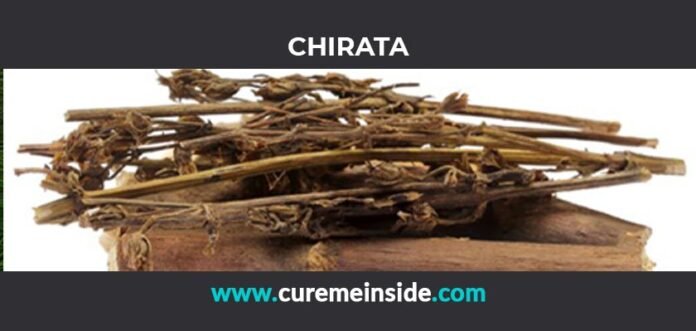Chirata (Swertia chirata)
Chirata is a well-known medicinal herb that is mostly grown and farmed in the Himalayas, Nepal, and Bhutan.(HR/1)
Because of the presence of different bioactive chemicals, chirata has a bitter flavour. Antibacterial, antifungal, antiviral, anticancer, cardiac stimulant, anti-inflammatory, antidiabetic, antioxidant, antipyretic, anthelmintic, antiperiodic, cathartic are some of the pharmacological effects of these components. Chronic fever, malaria, anaemia, bronchial asthma, hepatotoxic disorders, liver disorders, hepatitis, gastritis, constipation, dyspepsia, skin diseases, worms, epilepsy, ulcers, scanty urine, hypertension, melancholia, and certain types of mental disorders, bile secretion, blood purification, and diabetes are some of the conditions that these activities help with.
Chirata is also known as :- Swertia chirata, Kirataka, Bhunimba, Kiratatiktaka, Chirta, Chirata, Chireta, Kariyatu, Kariyatun, Nalebevu, Chirata Kaddi, Chirayat, Chiraita, Nelaveppu, Kirayathu, Nilamakanjiram, Kiraita, Kaduchiraita, Chireita, Chiretta, Nilavembu, Nelavemu, Kirata
Chirata is obtained from :- Plant
Uses and benefits of Chirata:-
As per several scientific studies, uses and benefits of Chirata (Swertia chirata) are mentioned as per below(HR/2)
- Malaria : Chirata may be useful in treating Malaria symptoms because it contains antimalarial components. It may aid in the prevention of malarial parasite development. Chirata also has antipyretic properties, which aid in the treatment of malarial fever by lowering body temperature.
“Chirata is a well-known Ayurvedic plant that is used to treat Malaria symptoms. Malaria fever is termed as Vishamajwara in Ayurveda (intermittent fever). Fever with irregular start and remission, extreme thirst, heaviness in the body, generalised body pain, headache, rigours, nausea, and vomiting are all symptoms of Vishamajwara (Malaria). Chirata’s Jvaraghna (antipyretic) and antimalarial characteristics aid to alleviate the symptoms of Vishamajvara (Malaria). To produce Chirata decoction at home to treat Malaria symptoms, follow these instructions: 1. Take Chirata, either raw or dry (whole plant). 2. Reduce it to 1/4th of its original volume by boiling it in 1 cup of water. 3. To help manage Malaria symptoms, filter this water and drink 3-4 tablespoons twice a day after meals. - Constipation : Chirata’s powerful laxative properties may help reduce constipation. It works as a natural laxative, promoting bowel movement and facilitating stool elimination from the body.
The Vata and Pitta doshas are exacerbated, resulting in constipation. This can be caused by eating too much junk food, drinking too much coffee or tea, sleeping too late at night, stress, or despair. Vata and Pitta are aggravated by all of these causes, resulting in constipation. Chirata’s Rechana (laxative) nature facilitates bowel movement and aids in the evacuation of waste materials from the body. To brew a Chirata decoction at home to relieve constipation, follow these steps: 1. Take raw or dried chirata (whole plant). 2. Reduce it to 1/4th of its original volume by boiling it in 1 cup of water. 3. To relieve constipation, filter this water and drink 3-4 tablespoons twice a day after meals. - Worm infections : Chirata’s anthelmintic properties may reduce the likelihood of parasitic Worm infections. It inhibits parasite activity and aids in their elimination from the body.
Worms are known as Krimi in Ayurveda. They multiply in the intestine and injure the body. Chirata powder’s Krimighna (anti-worm) property aids in the management of Worm infestation. It aids in the elimination of parasites from the digestive tract by destroying the circumstances that allow them to thrive. 1. Take 1-3 mg of Chirata powder (or as advised by a physician) to treat Worm infestation. 2. Reduce the bitterness by mixing it with jaggery. 3. To get rid of parasitic worms and manage infestation, swallow it with water once or twice a day. - Appetite stimulant : Chirata may help manage hunger, despite the lack of sufficient scientific data. It functions as an appetite suppressant and aids digestion.
- Stomach upset : Certain Chirata components may aid in the management of symptoms of an upset stomach, such as acidity or gas. It aids digestion and strengthens the stomach, resulting in relief from an upset stomach.
- Acne and Pimples : “A skin type with the Kapha-Pitta dosha can be prone to acne and pimples. Kapha aggravation, according to Ayurveda, promotes sebum production, which clogs pores. Both white and blackheads occur as a result of this. Pitta aggravation also results in red papules (bumps) and pus-filled inflammation. Chirata balances Kapha and Pitta, which aids in the removal of blockages and inflammation. Chirata for Acne and Pimples: Here’s a tip for using Chirata to get rid of acne and pimples: a. Take 1-6 grammes of Chirata powder, or as needed, according on your needs. c. Mix in some honey or rose water to make a paste. c. Distribute evenly across the face. c. Set aside for 15-20 minutes to allow the flavours to meld. e. Rinse well under running water. f. Apply this solution 2-3 times a week to get rid of Acne and Pimples, as well as fine lines and wrinkles and glowing skin.
- Skin disease : When applied to the affected area, Chirata helps to reduce the symptoms of skin illnesses such as eczema. Rough skin, blisters, inflammation, itching, and bleeding are some of the symptoms of eczema. Because of its Ropan (healing) and Sita (cooling) characteristics, Chirata powder or paste helps to reduce inflammation and halt bleeding. Tip for using Chirata to help treat skin disease: a. Take 1-6 gm (or as needed) of Chirata powder. b. Mix in the coconut oil to produce a paste. b. Using the paste, apply it to the affected region. d. Give yourself at least 4-5 hours.
- Wound healing : Chirata promotes faster wound healing, reduces swelling, and restores the skin’s natural texture. Due to its Ropan (healing) and Pitta balancing characteristics, a paste of Chirata powder with coconut oil aids in rapid healing and minimises inflammation. a. Use Chirata powder to improve wound healing: b. Take 1-6 gm (or as needed) of Chirata powder. c. Mix in the coconut oil to produce a paste. d. Using the paste, apply it to the affected region. e. Allow a minimum of 4-5 hours for wound healing.
Video Tutorial
Precautions to be taken while using Chirata:-
As per several scientific studies, below precautions should to be taken while taking Chirata (Swertia chirata)(HR/3)
- Chirata is found to interfere with blood sugar levels during surgery. So, it is generally advisable not to use Chirata at least 2 weeks before surgery.
Special precautions to be taken while taking Chirata:-
As per several scientific studies, below special precautions should to be taken while taking Chirata (Swertia chirata)(HR/4)
- Breastfeeding : Because there isn’t enough scientific data, it’s best to avoid or check your doctor before using Chirata during nursing.
- Patients with diabetes : Chirata has the potential to reduce blood sugar levels. As a result, while using Chirata with antidiabetic medications, it is typically recommended that you monitor your blood glucose levels.
- Patients with heart disease : Because there isn’t enough scientific data, it’s best to avoid Chirata or check your doctor before taking it if you have heart disease.
- Pregnancy : Because there isn’t enough scientific data, it’s best to avoid Chirata during pregnancy or visit your doctor beforehand.
How to take Chirata:-
As per several scientific studies, Chirata (Swertia chirata) can be taken into the methods mentioned as per below(HR/5)
- Chirata powder : Take one to three gm (or as directed by a medical professional) of Chirata powder. Swallow it with lukewarm water once or twice a day. Consume it daily to manage worm infestations, or, Take one to 6 gm of Chirata or based on your requirement. Add honey or increased water to it. Apply uniformly on the face. Let it rest for fifteen to twenty minutes. Wash completely with faucet water. Use this remedy two to three times a week to minimize great lines, wrinkles and also get a radiant skin.
- Chirata Decoction : Take raw or dried Chirata (whole plant). Boil it in one mug of water till it is lowered to one fourth of its initial quantity. Filter this water and drink three to four teaspoons of it twice a day. Consume it daily to obtain remedy for bowel irregularity.
- Chirata Tablets : Take one tablet a day or as guided by the doctor. Swallow it with water one to two times a day.
- Chirata Capsules : Take one pill a day or as guided by the doctor. Swallow it with water one to two times a day. Consume it daily for blood filtration.
How much Chirata should be taken:-
As per several scientific studies, Chirata (Swertia chirata) should be taken into the amounts mentioned as per below(HR/6)
Side effects of Chirata:-
As per several scientific studies, below side effects need to be taken into consideration while taking Chirata (Swertia chirata)(HR/7)
- Dizziness
- Numbness in hands
Questions asked frequently Related to the Chirata:-
Question. How do you store chirata powder?
Answer. Chirata powder should be kept in a sterile, clean environment.
Question. Is Chirata good for diabetes?
Answer. Chirata’s antioxidant and anti-inflammatory qualities may aid with diabetes management. It protects pancreatic cells from injury and improves insulin release. This aids in the reduction of blood sugar levels.
Question. Is Chirata good for diabetes?
Answer. Chirata’s antioxidant and anti-inflammatory qualities may aid with diabetes management. It protects pancreatic cells from injury and improves insulin release. This aids in the reduction of blood sugar levels.
Question. Is Chirata good for the liver?
Answer. Because of its antioxidant and liver-protective properties, chirata is beneficial to the liver. Antioxidants help to protect liver cells from free radical damage and to remove them from the body. Chirata’s anti-inflammatory properties also help to minimise liver inflammation.
Question. Is Chirata good for fever?
Answer. Because certain elements of Chirata root have antipyretic effect, it may be useful in the treatment of fever. According to various research, these antipyretic drugs aid in the reduction of increased body temperature.
Question. How does Chirata help in weight loss?
Answer. Chirata contains methanol, which aids weight loss by increasing body metabolism.
Question. Does Chirata help in anemia?
Answer. Yes, Chirata may aid in the treatment of anaemia by promoting blood formation in the body.
Question. Can Chirata cause vomiting?
Answer. Because Chirata has a harsh flavour, it may cause vomiting in certain people.
Question. Can Chirata result in hypoglycemia?
Answer. Chirata may cause hypoglycemia by lowering blood sugar levels (low blood sugar level). If you’re using Chirata with another anti-diabetic medication, it’s a good idea to keep a close eye on your blood sugar levels.
Question. How does Chirata helps manage skin diseases ?
Answer. Because of its antibacterial and anti-inflammatory characteristics, Chirata paste can be used externally to treat skin conditions including eczema and pimples. It lowers the bacterial action on the body, as well as the inflammation, agony, and redness that acne and pimples cause.
Question. Is Chirata good for Contagiosa
Answer. Contagiosa is a contagious inflammatory condition that affects the face. Chirata’s anti-inflammatory properties help to lessen the redness and irritation associated with Contagiosa.
Question. Does Chirata help in wound healing?
Answer. Because of its antioxidant, anti-inflammatory, and antibacterial qualities, Chirata paste can be applied externally to aid wound healing. Chirata has compounds that aid in the contraction and closure of wounds. It also aids in skin cell regeneration and enhances wound healing.
Question. Can Chirata protect you from microbial infections?
Answer. Chirata’s antibacterial properties can protect you from a variety of microbiological illnesses. It prevents the growth of bacteria that cause infections in the intestines and lungs.
SUMMARY
Because of the presence of different bioactive chemicals, chirata has a bitter flavour. Antibacterial, antifungal, antiviral, anticancer, cardiac stimulant, anti-inflammatory, antidiabetic, antioxidant, antipyretic, anthelmintic, antiperiodic, cathartic are some of the pharmacological effects of these components.




